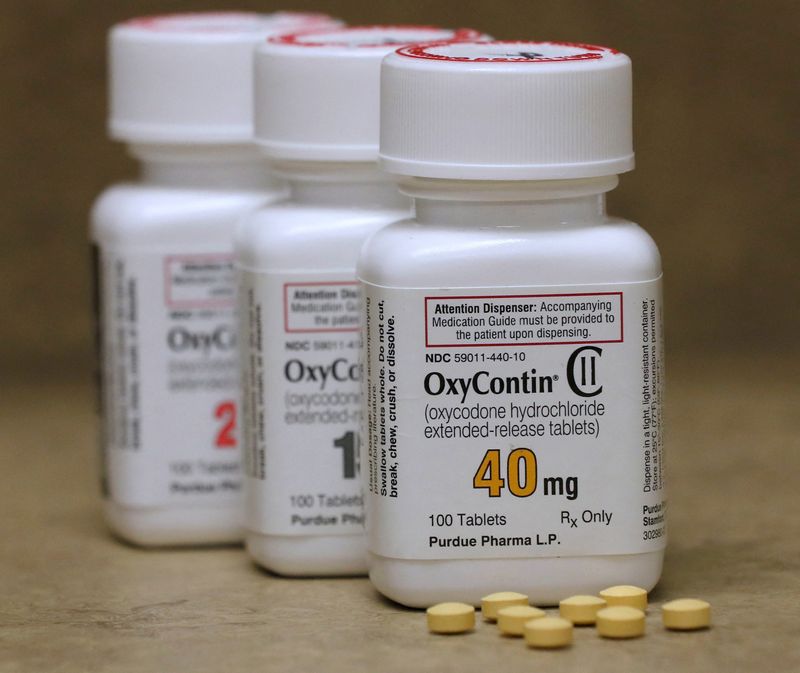By Dietrich Knauth
NEW YORK (Reuters) -Bankruptcy may become a less attractive way to resolve sprawling lawsuits after a U.S. Supreme Court ruling scuttled OxyContin maker Purdue Pharma's Chapter 11 settlement and sharply scaled back a court's ability to wipe away legal claims against entities that have not filed for bankruptcy themselves.
Bankruptcy courts offer several attractive tools for companies and other organizations to settle mass tort litigation, which have been used in cases involving claims of widespread sexual abuse against Catholic dioceses and the Boy Scouts of America, the marketing and sale of addictive opioid painkillers, and that consumer products cause cancer.
A bankruptcy proceeding automatically stops litigation from moving forward, giving debtors a breathing spell to allow for a reorganization or global settlement. It can bind holdout claimants who won't consent to a settlement offer, and even allows debtors to permanently resolve similar claims that might arise in the future.
Until Thursday's Purdue decision, bankruptcy could also be used to provide so-called non-debtor releases that provide sweeping civil immunity to companies, people or organizations that have not filed for bankruptcy themselves. Outside parties often contributed funding for a bankruptcy settlement in exchange for that legal shield.
Those tools were meant to serve bankruptcy's broader purpose of giving a fresh start to people or entities overwhelmed by debts. But bankruptcy is increasingly used - and, some critics allege, abused - by wealthy corporations and defendants who are threatened by costly lawsuits instead of traditional debts.
The Supreme Court with Thursday's Purdue decision took that option off the table, ruling that nothing in U.S. bankruptcy law allows courts to release legal claims against non-debtors without the consent of the people who sued them.
The Purdue deal would have protected the company's wealthy owners, members of the Sackler family, from lawsuits alleging they and their company created an opioid addiction crisis through their misleading marketing of the painkiller OxyContin even though they did not file for bankruptcy themselves.
The Sacklers were prepared to pay up to $6 billion for their part of the settlement, all of which would have been devoted to addressing harms caused by the opioid crisis.
The Purdue ruling will place more pressure on other strategies for resolving mass torts, such as consolidating cases in a federal multidistrict litigation or conducting a lengthy series of trials in other courts.
'CRITICAL TOOL'
Some experts, like University of Chicago Law professor Anthony Casey, fear that resolving mass tort cases outside of bankruptcy will result in less money for victims, because outside parties, like the Sacklers or company insurers, often kick in real settlement money in exchange for non-debtor releases to get finality on their own liability.
In a dissenting opinion to Thursday's decision, Justice Brett Kavanaugh said non-debtor releases "have long been a critical tool for bankruptcy courts to manage mass-tort bankruptcies" and that the Purdue settlement "was a shining example of the bankruptcy system at work."
Without legal protections for the Sacklers, communities and individuals harmed by the opioid crisis risk losing $7 billion in funding, most of which was provided by the Sackler settlement, Kavanaugh wrote.
Organizations like the Boy Scouts of America and Catholic dioceses have argued bankruptcy is the only way to comprehensively address their legal problems, and that non-debtor releases are essential for gathering contributions from outside organizations that may also have liability for alleged harms.
The finality of a bankruptcy release provides incentive to related parties to chip in to a deal instead of holding out funds for their own defense in future lawsuits, according to advocates.
"Bankruptcy offers a superior forum in which to resolve mass tort claims because it gathers the largest possible pool of available assets to pay the largest number of claimants," the Chamber of Commerce and American Tort Reform Association wrote in an amicus brief filed in the Purdue case.
Outside of bankruptcy, mass torts can result in a "race to the courthouse" and a never-ending series of "lottery-like" trials, in which some claimants get massive payouts and others get nothing, tort reform advocates say.
Melissa Jacoby, a UNC law professor and author of Unjust Debts, said those fears are overblown, and that companies will simply have to offer better settlement payouts in order to win over tort victims, rather than leveraging the threat of a bankruptcy release to coerce a settlement.
Justice Neal Gorsuch, writing for the majority in Purdue, said the Sacklers may be willing to chip in more money to buy off holdout litigants who did not vote for the deal, as they did earlier in the bankruptcy case.
But debates about the settlement money are better addressed in Congress or other forums, because the law simply does not allow for the Sackler releases, Gorsuch wrote.
Massive cases have settled outside of bankruptcy.

Industrial conglomerate 3M, for example, tried to use the bankruptcy of its subsidiary Aearo to resolve about 300,000 lawsuits alleging the company sold defective earplugs to the U.S. military. 3M had argued the case, which grew into the largest mass tort in U.S. history, showed the system "is no longer a viable forum" to resolve sprawling lawsuits and was "broken beyond repair."
However, once a bankruptcy court dismissed Aearo's Chapter 11 as an improper effort to shield 3M from lawsuits, it quickly reached a $6 billion settlement outside of bankruptcy.